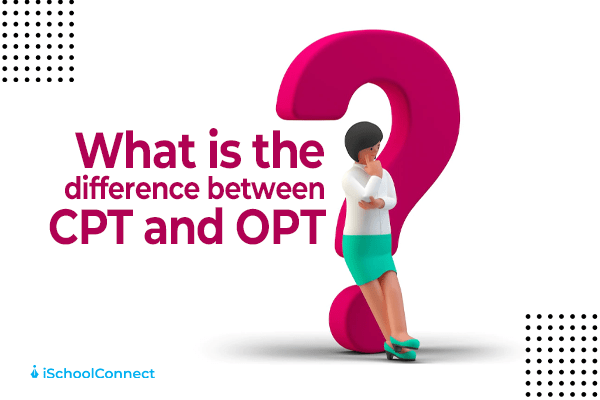Table of Contents
Curricular Practical Training (CPT) and Optional Practical Training (OPT) are essential for F-1 students seeking practical experience. CPT allows you to work before graduation, while OPT offers career opportunities after earning your degree. Knowing the difference between OPT and CPT for international students is vital, as both programs help you develop skills and connections in your field.
Are you an international student ready to launch your career in the U.S.? Understanding Curricular Practical Training (CPT) and Optional Practical Training (OPT) is essential for gaining valuable work experience during and after your studies. In this guide, we’ll cover everything you need to know about these programs, including the crucial difference between OPT and CPT for international students. Whether you’re aiming for an internship before graduation or seeking to extend your career options post-degree, we’ve got you covered. Let’s get started!
What is CPT?
Curricular Practical Training (CPT) is a work authorization for international students on F-1 visas, allowing them to gain practical experience related to their academic program through internships, co-ops, or practicums. It can be part-time (up to 20 hours/week) or full-time (over 20 hours/week) and must be completed before graduation. However, working full-time in CPT for 12 months makes students ineligible for Optional Practical Training (OPT). The CPT visa validity is employer-specific, and it helps students gain valuable work experience while earning in U.S. dollars.
Types of CPT
CPT can be categorized into two types: Part-time CPT & Full-Time CPT.
- Part-Time CPT: Students can work up to 20 hours per week while classes are in session. This option is ideal for gaining practical experience without impinging academic responsibilities.
- Full-Time CPT: During academic breaks or when required by the program, students can work more than 20 hours per week. However, it’s important to note that completing 12 months of full-time CPT will make students ineligible for Optional Practical Training (OPT).
Essential Things to Note for CPT
- Off-Campus Employment: CPT is exclusively available for off-campus work assignments and opportunities. The CPT visa validity is limited to your academic years.
- Authorization Period: CPT authorization is generally granted for one semester or summer session at a time.
- Duration Limit: You can participate in CPT for a maximum of 12 months throughout your entire course of study.
- Full Course Requirement: To be eligible for CPT, you must maintain a full course of study.
- Employment Status: If you are not able to keep your job or drop below a full course load, your CPT authorization will be nullified.
Documents Checklist for CPT Visa
To apply for Curricular Practical Training (CPT), you typically need the following documents:
- CPT Online Workshop Completion Certificate: Proof of completion of any required training or workshop.
- Academic Recommendation Form: A form filled out by your academic advisor or instructor recommending you for CPT.
- Detailed Description of Training: A description of the training or job responsibilities provided by your employer.
- Copy of Current I-20 Form: Your most recent Form I-20, which indicates your student status.
- Printout of Electronic Form I-94: A copy of your I-94, which records your arrival in the U.S.
Check if you are eligible for a CPT Visa
To be eligible for CPT, a student must meet the following criteria:
- F-1 Visa Status: Must be in valid F-1 status.
- Enrollment Duration: Must have been enrolled for at least one academic year before starting employment.
- Employment Offer: Must possess a specific job offer that aligns with the institution’s requirements for the relevant course.
What is OPT?
OPT, or Optional Practical Training, is a temporary employment program for F-1 students in the United States. It allows international students to work for up to 12 months in jobs related to their field of study, providing judicious work experience.
STEM graduates can extend their OPT period by an additional 24 months, bringing the total to 17 months. While students must receive a recommendation from their university’s international office, final approval is granted by USCIS. Students can apply for OPT either before completing their studies (pre-completion) or after (post-completion), with pre-completion time deducted from the total post-completion allowance.
Essential Things to Note for OPT
- Duration: OPT allows up to 12 months of work related to your field of study, with a 17-month extension for STEM graduates.
- USCIS Approval: Participation requires approval from USCIS.
- Processing Time: Applications typically take 3 to 4 months to process.
- Eligibility: You must have valid F-1 status and have been enrolled full-time for at least one academic year at an accredited U.S. institution.
- Job Offer: A job offer is not required to apply, but the work must relate to your field.
- Application Window: You can apply 3 months before and 1 month after completing your program.
- Pre-Completion Deduction: Time spent on pre-completion OPT is deducted from your total post-completion OPT period.
Document Checklist for OPT Visa
Applicants should directly contact the international office at their respective institutions for specific document requirements. However, the following documents are generally necessary for applying for Optional Practical Training (OPT):
- Two Passport-Size Photographs: Recent passport-sized photos as per the specified requirements.
- Form I-765: The original completed Form I-765 for employment authorization.
- Current Passport Copy: A copy of your valid passport.
- Printout of I-94: A copy of your electronic Form I-94, which documents your arrival in the U.S.
- Payment: A personal check for US$380 (subject to change), made out to the Department of Homeland Security.
- OPT Recommendation and I-20: A copy of the OPT recommendation letter and your current Form I-20.
- Previous I-20 Copies: Copies of all previously issued Form I-20 documents.
- EAD Card Copies: Any previously issued Employment Authorization Document (EAD) card copies.
- F-1 Visa Stamp Copy: A copy of the F-1 visa stamp in your passport.
Check if you are eligible for an OPT Visa
To be eligible for an OPT visa, a student must meet the following criteria:
- F-1 Visa Status: Must be in valid F-1 status.
- Full-Time Enrollment: Must be enrolled full-time for at least one academic year before starting employment.
- CPT Limitation: Must not have utilized 12 months or more of full-time Curricular Practical Training (CPT).
Difference between OPT and CPT for International Students
Understanding the difference between OPT and CPT for international students is essential for making informed career choices in the U.S. This table outlines the key features of each program to help you navigate your options effectively.
Feature | CPT | OPT |
Objective | Provides a wholesome practical experience before graduation | Fosters a knowledge-driven practical experience after graduation |
Eligibility | Available to F-1 visa holders looking for pre-graduation work experience | Available to F-1 visa holders seeking employment before or after graduation |
Full Form | Curricular Practical Training | Optional Practical Training |
Organization of Training | While the student is enrolled | After graduation |
Training Host | Final consent is given by the International Student Services (ISS) and academic department | Final say and approval is derived from USCIS (U.S. government) |
Application Mode | Online | Paper |
Duration of Employment | Up to 12 months | 12 months, extendable up to 24 months |
Employment Authorization Document (EAD) | No EAD issued for CPT | EAD issued after OPT approval |
Application Fee | No application fee | 34,464.82 INR (approximately $410) |
Working Part-Time/Full-Time | Can be part-time (20 hours/week) or full-time (up to 40 hours during summer) | Generally full-time after graduation |
Employment Type | Any employer across the U.S. | Limited to employers on the I-20 list and SEVIS |
STEM Extension | Not available | Available |
In conclusion, knowing the difference between OPT and CPT for international students can significantly impact your professional journey in the U.S. Choose the option that best aligns with your educational goals and career aspirations.
CPT and OPT Visa Rules
Here’s a detailed overview of the rules for CPT and OPT visas:
Curricular Practical Training (CPT) Visa Rules
Curricular Practical Training (CPT) allows international students on F-1 visas to intern in the U.S. during their academic program. Here are the key points regarding CPT:
- Internship Process: To participate in CPT, students must first secure an internship and then have their college issue a CPT authorization.
- Visa Requirements: No separate visa is needed for CPT; students can complete CPT while on their F-1 visa.
- Duration and Hours: CPT is semester-specific and can last from one semester up to 364 days. Students may work part-time (up to 20 hours per week) when classes are in session and full-time during breaks.
- Employer Specificity: Students can only work for employers listed on their I-20 and SEVIS records.
- Authorization and Processing: CPT is authorized by the International Student and Scholar Services (ISSS), which issues a new I-20 with a CPT recommendation. The processing time for CPT is typically 5 to 7 business days, allowing for quick authorization.
- Employment Dates: Employment is permitted only during the dates specified in the CPT recommendation on the I-20 and SEVIS.
Optional Practical Training (OPT) Visa Rules
Optional Practical Training (OPT) is a work authorization available to students upon completing their degree programs in the U.S. Here are the main aspects of OPT:
- Work Permit Duration: OPT provides a one-year work permit, requiring students to secure a job within 90 days post-graduation.
- Field Relevance: Jobs obtained under OPT must be directly related to the student’s major field of study.
- No Course Registration Required: Unlike CPT, there is no requirement for course registration during OPT.
- Employer Flexibility: OPT is not employer-specific, meaning students can work for any employer as long as the job relates to their field of study.
- Authorization Process: Both ISSS and USCIS must authorize OPT. ISSS issues a new I-20 with an OPT recommendation, while USCIS issues the Employment Authorization Document (EAD) card.
- Processing Time and Fees: OPT processing times vary but generally range from 1 to 3 months. The EAD card, which allows employment during its validity period, has a 34,464.82 INR application fee. After the EAD expires, students must apply for an H-1B visa (work visa) to continue employment.
Understanding the difference between OPT and CPT for international students is crucial for making informed decisions about work opportunities during and after your studies.
Key Takeaways
- CPT allows F-1 students to work before graduation, while OPT provides post-graduation work authorization for up to 12 months.
- CPT requires securing an internship and being enrolled for at least one academic year. OPT also requires valid F-1 status and at least one year of full-time enrollment.
- CPT is authorized by the International Student and Scholar Services (ISSS) via a new I-20, whereas OPT requires approval from both ISSS and USCIS for an Employment Authorization Document (EAD).
- OPT visa validity and CPT validity differ, as CPT is employer-specific and limited by semester, while OPT allows for broader employment opportunities in the student’s field of study. This highlights the difference between OPT and CPT for international students in terms of flexibility and job options.
We hope that this difference between OPT and CPT for international students helped you understand your future work options. If you have more questions about studying, living, or working abroad, make sure you check out some of our top blogs for further guidance.
You can also email us any questions you can also contact us and let us know your thoughts in the comments below!
FAQs
Ques 1. How long is the OPT valid?
Answer 1 – OPT is typically valid for 12 months. However, students in STEM fields may qualify for an additional 24-month extension.
Ques 2. How many hours can I work during CPT?
Answer 2 – You can work up to 40 hours per week during CPT.
Ques 3. Can I work for more than one CPT at a time?
Answer 3– Yes, you can have more than one CPT, but each requires separate authorization for each employer and CPT assignment.






